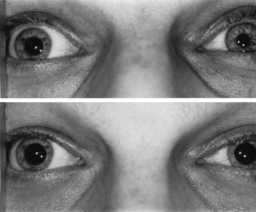Question:
How often is a dilation lag present in a patient with Horner Syndrome on the initial examination?
1. 100%
2. 85%
3. 70%
4. 50%
 1
1
Left-sided dilation lag in a 29-year-old man with Horner’s syndrome caused by a posterior mediastinal ganglioneuroma. Note that the degree of anisocoria is greater after 5 seconds in darkness (top) compared with findings after 15 seconds in darkness (bottom).
___________________________________________________
Correct Answer: 2. 85%
Explanation2:
Abstract:
PURPOSE: To examine the repeatability of detecting pupillary dilation lag in patients with Horner syndrome.
DESIGN: Retrospective interventional study.
METHODS: Setting: Single referral institution. Patient population: Fifteen patients with unilateral Horner syndrome and 16 subjects with physiologic anisocoria. Intervention procedure: Each subject underwent four pupillometric recordings in darkness. The asymmetry of pupillodilation between the two eyes was calculated as the change in anisocoria between five seconds and 15 seconds in darkness. Pupillary dilation lag was considered present if the asymmetry measured > or =0.4 mm. Main outcome measure: Asymmetry of pupillodilation over four determinations.
RESULTS: All subjects demonstrated fluctuations in the calculated asymmetry of pupillodilation. Eight patients(53%) with Horner syndrome demonstrated dilation lag on the first determination; 13 patients (87%) eventually demonstrated it during four determinations.
CONCLUSIONS: Pupillary dilation lag is intermittently present in most patients with Horner syndrome. Repeated observations improve the detection rate of dilation lag, a confirmatory sign of an oculosympathetic deficit. Its absence does not rule out Horner syndrome.
Videos
Horner Syndrome Dilation Lag. Digre KB. John A Moran Eye Center https://www.youtube.com/watch?v=hNUXRH2q570
Sam Tapsell How to Examine Horner’s Syndrome http://www.youtube.com/watch?v=JBVGh0gyyYc
References:
1. Left-sided dilation lag in a man with Horner’s syndrome. The John Moran Eye Center Collection. http://content.lib.utah.edu/cdm/singleitem/collection/EHSL-Moran-Neuro-opth/id/120/rec/
2. Pupillary dilation lag is intermittently present in patients with a stable oculosympathetic defect (Horner syndrome). Crippa SV, Borruat FX, Kawasaki A. Am J Ophthalmol. 2007; 143(4):712-5
More than 600 additional neuro-ophthalmology questions are freely available at http://EyeQuiz.com.
Questions prior to September 2016 are archived at http://ophthalmology.stanford.edu/blog/
After that, questions are archived at https://neuro-ophthalmology.stanford.edu
Follow https://twitter.com/NeuroOphthQandA to be notified of new neuro-ophthalmology questions of the week.
Please send feedback, questions and corrections to tcooper@stanford.edu.